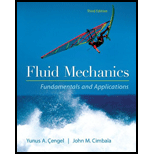
The error involved for each case and asses the accuracy of strokes law.
Answer to Problem 113P
In first ball
In second ball
In third ball
Explanation of Solution
Given information:
The diameter of the first aluminum ball is
Write the expression of drag force acting on the freely falling body.
Here, the weight of the ball is
Write the expression of drag force by strokes law.
Here, the terminal velocity is
Write the expression of the weight of the body.
Here, the density of the ball is
Write the expression of bouncy force applied by a body.
Here, the density of the fluid is
Substitute
Write the expression of volume of the ball.
Write the expression of percentage error.
Here, the given terminal velocity is
Calculation:
For First ball,
Substitute
Substitute
Taking positive sign.
Taking Negative sign.
Here, the negative value of velocity is not desirable so the velocity is
Substitute
In first ball
For Second ball,
Substitute
Substitute
Taking positive sign.
Taking Negative sign.
Here, the negative value of velocity is not desirable so the velocity is
Substitute
In second ball
For Third ball.
Substitute
Substitute
Taking positive sign.
Taking Negative sign.
Here, the negative value of velocity is not desirable so the velocity is
Substitute
In third ball
Conclusion:
In first ball
In second ball
In third ball
Want to see more full solutions like this?
Chapter 11 Solutions
Fluid Mechanics Fundamentals And Applications
- A proposed three-dimensional incompressible fl ow fi eldhas the following vector form:V = Kxi + Kyj - 2Kzk( a ) Determine if this fi eld is a valid solution to continuityand Navier-Stokes. ( b ) If g = - g k, fi nd the pressure fi eldp ( x , y , z ). ( c ) Is the fl ow irrotational?arrow_forwardHow do I solve these questions?: a) Start with Navier-Stokes equations and determine the velocity at the point x = 4 cm and y= 0.58 cm. The value of the velocity is ________ b) Calculate the magnitude of the vorticity at the same point. The magnitude value of vorticity is ________ c) Calculate the rate of angular deformation at the same point. The angular deformation value is ________arrow_forwardQ2:: Discuss the usefulness of Navier-Stokes equation with the help of practical examples.arrow_forward
- How does the Navier-Stokes equation encapsulate the complexities of fluid behavior, and what challenges arise when attempting to solve it in the context of mechanical engineering's fluid mechanicsarrow_forwardHow do you recognize a boundary layer? Cite some physicalproperties and some measurements that reveal appropriatecharacteristics.arrow_forwardDerive the Navier stokes equation in detail.If you copy from other source I will give you thumbs down.arrow_forward
- Answer the following. Must answer all the questions. Dont attempt partially. i. Description of external flow phenomena, ii. Effect of boundary layer theory on external flow iii. Explanation of Reynold’s number and its significance on external flow studies.arrow_forwardWhat is the definition of a pathline? What do pathlines indicate?arrow_forwardBy neglecting friction, ( a ) use the Bernoulli equationbetween surfaces 1 and 2 to estimate the volume fl owthrough the orifi ce, whose diameter is 3 cm. ( b ) Why is theresult to part ( a ) absurd? ( c ) Suggest a way to resolve thisparadox and fi nd the true fl ow rate.arrow_forward
- Show that the incompressible flow distribution, in cylindricalcoordinates,vr = 0 vθ = Crn vz = 0where C is a constant, ( a ) satisfies the Navier-Stokes equationfor only two values of n . Neglect gravity. ( b ) Knowingthat p = p ( r ) only, fi nd the pressure distribution for eachcase, assuming that the pressure at r = R is p 0 . What mightthese two cases represent?arrow_forwardWrite out the three components of the Navier–Stokes equation in Cartesian coordinates in terms of modified pressure. Insert the definition of modified pressure and show that the x-, y-, and z-components are identical to those in terms of regular pressure. What is the advantage of using modified pressure?arrow_forwardWhat criteria can you use to determine whether an approximation of the Navier–Stokes equation is appropriate or not? Explain.arrow_forward
 Elements Of ElectromagneticsMechanical EngineeringISBN:9780190698614Author:Sadiku, Matthew N. O.Publisher:Oxford University Press
Elements Of ElectromagneticsMechanical EngineeringISBN:9780190698614Author:Sadiku, Matthew N. O.Publisher:Oxford University Press Mechanics of Materials (10th Edition)Mechanical EngineeringISBN:9780134319650Author:Russell C. HibbelerPublisher:PEARSON
Mechanics of Materials (10th Edition)Mechanical EngineeringISBN:9780134319650Author:Russell C. HibbelerPublisher:PEARSON Thermodynamics: An Engineering ApproachMechanical EngineeringISBN:9781259822674Author:Yunus A. Cengel Dr., Michael A. BolesPublisher:McGraw-Hill Education
Thermodynamics: An Engineering ApproachMechanical EngineeringISBN:9781259822674Author:Yunus A. Cengel Dr., Michael A. BolesPublisher:McGraw-Hill Education Control Systems EngineeringMechanical EngineeringISBN:9781118170519Author:Norman S. NisePublisher:WILEY
Control Systems EngineeringMechanical EngineeringISBN:9781118170519Author:Norman S. NisePublisher:WILEY Mechanics of Materials (MindTap Course List)Mechanical EngineeringISBN:9781337093347Author:Barry J. Goodno, James M. GerePublisher:Cengage Learning
Mechanics of Materials (MindTap Course List)Mechanical EngineeringISBN:9781337093347Author:Barry J. Goodno, James M. GerePublisher:Cengage Learning Engineering Mechanics: StaticsMechanical EngineeringISBN:9781118807330Author:James L. Meriam, L. G. Kraige, J. N. BoltonPublisher:WILEY
Engineering Mechanics: StaticsMechanical EngineeringISBN:9781118807330Author:James L. Meriam, L. G. Kraige, J. N. BoltonPublisher:WILEY





